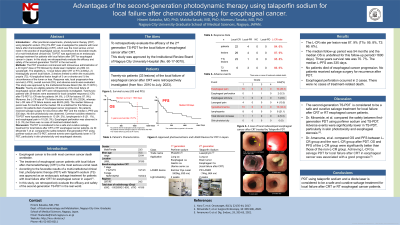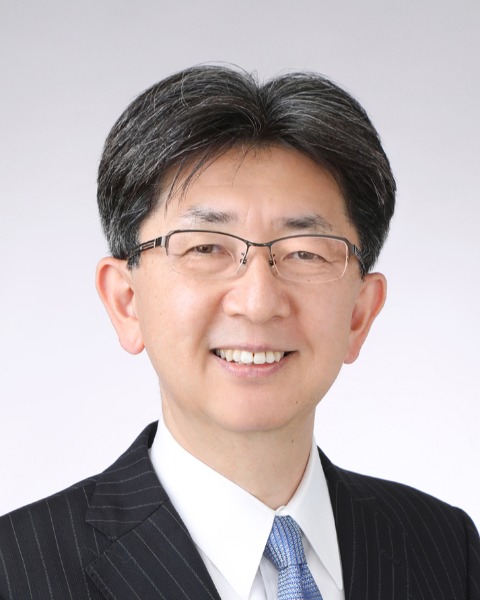Monday Poster Session
Category: Esophagus
P1855 - Advantages of the Second-Generation Photodynamic Therapy Using Talaporfin Sodium for Local Failure After Chemoradiotherapy for Esophageal Cancer
Monday, October 23, 2023
10:30 AM - 4:15 PM PT
Location: Exhibit Hall

Has Audio

Hiromi Kataoka, MD, PhD
Nagoya City University Graduate School of Medical Sciences
Nagoya, Aichi, Japan
Presenting Author(s)
Hiromi Kataoka, MD, PhD, Makiko Sasaki, MD, PhD, Mamoru Tanaka, MD, PhD
Nagoya City University Graduate School of Medical Sciences, Nagoya, Aichi, Japan
Introduction: After preclinical experiments, photodynamic therapy (PDT) using talaporfin sodium (TS) (TS-PDT) was investigated for patients with local failure after chemoradiotherapy (CRT), which was the most serious unmet need in the practice of esophageal cancer. According to the favorable results of a multi-institutional clinical trial, TS-PDT was approved as an endoscopic salvage treatment for patients with local failure after CRT for esophageal cancer in Japan. In this study, we retrospectively evaluate the efficacy and safety of the second-generation TS-PDT in the real world.
Methods: The PDT procedure commenced with intravenous administration of a 40 mg/m2 dose of TS followed by diode laser irradiation at a 664 nm wavelength. The eligibility is, 1) local failure after CRT or RT (≧50Gy), 2) histologically proven local failure, 3) lesions limited to within the muscularis propria (T2), 4) longitudinal lesion length of 3 cm or shorter and ½ the circumference of the lumen or less. Response rate, local progression-free survival (L-PFS), overall survival (OS), and adverse events were evaluated. This study was approved by the Institutional Review Board (No. 60-17-0070 ).
Results: Twenty-six eligible patients (33 lesions) of the local failure of esophageal cancer after CRT were retrospectively investigated. Twenty-two patients with 29 lesions were assessed for local complete response (L-CR) after TS-PDT (L-CR rate for patients: 84. 6%, L-CR for lesions: 87. 9%). Moreover, the L-CR rate of T1b failure lesions was 95. 8% (23/24), whereas the L-CR rate of T2 failure lesions was 66.6% (6/9). The median follow-up period was 54 months and the median OS is undefined for this follow-up period. No patients died of esophageal cancer progression. No patients received salvage surgery for recurrence after PDT and the median L-PFS was 543 days. No skin phototoxicity was observed. Common toxicities related to TS-PDT were hypoalbuminemia in 13 (34. 2%), lymphopenia in 8 (21. 1%), and esophageal pain in 10 (26. 3%). Esophageal perforation was observed in 2 (5. 3%) but there was no case of treatment-related death.
Discussion: TS-PDT is considered to be a safe and curative salvage treatment for local failure after CRT or RT esophageal cancer patients. As Dr. Minamide T. et al. compared the safety between first-generation PDT using porfimer sodium and TS-PDT, and they reported that the adverse events were significantly lower in TS-PDT, particularly in skin phototoxicity and esophageal stenosis.
Disclosures:
Hiromi Kataoka, MD, PhD, Makiko Sasaki, MD, PhD, Mamoru Tanaka, MD, PhD. P1855 - Advantages of the Second-Generation Photodynamic Therapy Using Talaporfin Sodium for Local Failure After Chemoradiotherapy for Esophageal Cancer, ACG 2023 Annual Scientific Meeting Abstracts. Vancouver, BC, Canada: American College of Gastroenterology.
Nagoya City University Graduate School of Medical Sciences, Nagoya, Aichi, Japan
Introduction: After preclinical experiments, photodynamic therapy (PDT) using talaporfin sodium (TS) (TS-PDT) was investigated for patients with local failure after chemoradiotherapy (CRT), which was the most serious unmet need in the practice of esophageal cancer. According to the favorable results of a multi-institutional clinical trial, TS-PDT was approved as an endoscopic salvage treatment for patients with local failure after CRT for esophageal cancer in Japan. In this study, we retrospectively evaluate the efficacy and safety of the second-generation TS-PDT in the real world.
Methods: The PDT procedure commenced with intravenous administration of a 40 mg/m2 dose of TS followed by diode laser irradiation at a 664 nm wavelength. The eligibility is, 1) local failure after CRT or RT (≧50Gy), 2) histologically proven local failure, 3) lesions limited to within the muscularis propria (T2), 4) longitudinal lesion length of 3 cm or shorter and ½ the circumference of the lumen or less. Response rate, local progression-free survival (L-PFS), overall survival (OS), and adverse events were evaluated. This study was approved by the Institutional Review Board (No. 60-17-0070 ).
Results: Twenty-six eligible patients (33 lesions) of the local failure of esophageal cancer after CRT were retrospectively investigated. Twenty-two patients with 29 lesions were assessed for local complete response (L-CR) after TS-PDT (L-CR rate for patients: 84. 6%, L-CR for lesions: 87. 9%). Moreover, the L-CR rate of T1b failure lesions was 95. 8% (23/24), whereas the L-CR rate of T2 failure lesions was 66.6% (6/9). The median follow-up period was 54 months and the median OS is undefined for this follow-up period. No patients died of esophageal cancer progression. No patients received salvage surgery for recurrence after PDT and the median L-PFS was 543 days. No skin phototoxicity was observed. Common toxicities related to TS-PDT were hypoalbuminemia in 13 (34. 2%), lymphopenia in 8 (21. 1%), and esophageal pain in 10 (26. 3%). Esophageal perforation was observed in 2 (5. 3%) but there was no case of treatment-related death.
Discussion: TS-PDT is considered to be a safe and curative salvage treatment for local failure after CRT or RT esophageal cancer patients. As Dr. Minamide T. et al. compared the safety between first-generation PDT using porfimer sodium and TS-PDT, and they reported that the adverse events were significantly lower in TS-PDT, particularly in skin phototoxicity and esophageal stenosis.
Disclosures:
Hiromi Kataoka indicated no relevant financial relationships.
Makiko Sasaki indicated no relevant financial relationships.
Mamoru Tanaka indicated no relevant financial relationships.
Hiromi Kataoka, MD, PhD, Makiko Sasaki, MD, PhD, Mamoru Tanaka, MD, PhD. P1855 - Advantages of the Second-Generation Photodynamic Therapy Using Talaporfin Sodium for Local Failure After Chemoradiotherapy for Esophageal Cancer, ACG 2023 Annual Scientific Meeting Abstracts. Vancouver, BC, Canada: American College of Gastroenterology.
